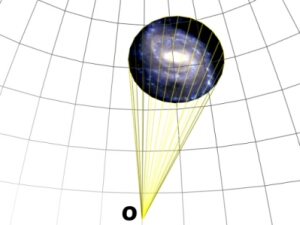Solid Angle
The solid angle is that fraction of the surface of a sphere that a particular object covers, as seen by an observer at the sphere’s centre. For a small region with area Δa, the numerical value of the solid angle is:
ΔΩ = Δa/r2
where r is the radius of the sphere. A physical representation of the solid angle is shown in the following diagram:

|

|
| For an observer at O, the galaxy will cover a small fraction of the surface of a sphere. The galaxy has a solid angle given by ΔΩ. | |
Although the solid angle is a dimensionless quantity, it is usually expressed in units of steradians (sr). The solid angle is often a function of direction.
As an example, a sphere has a solid angle of 4π≃12.57 sr, a factor that appears in the formula for the surface area of a sphere (radius r):
SA = 4πr2
Study Astronomy Online at Swinburne University
All material is © Swinburne University of Technology except where indicated.

